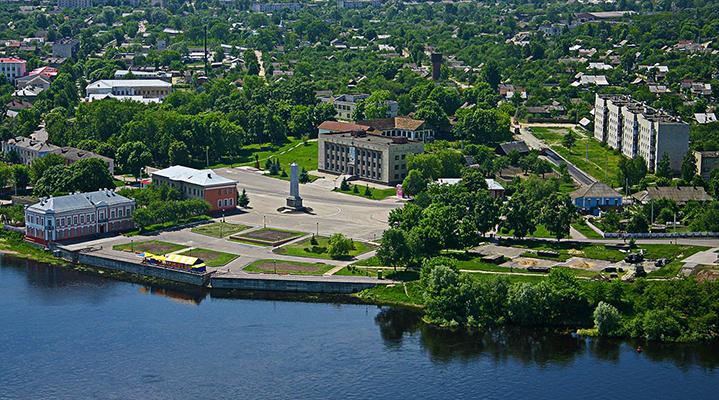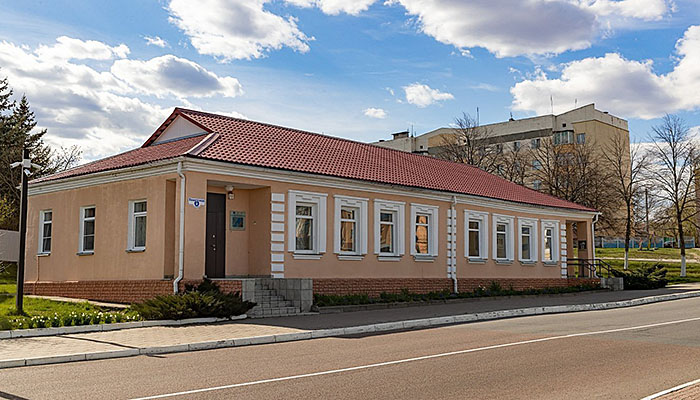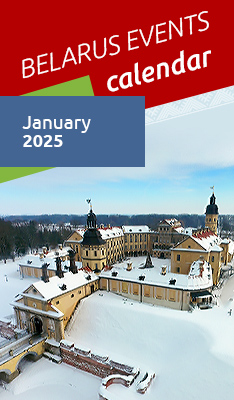Belarus Tour Guide: Ideas for Your Trip!
What to see in Loyev: Geological outcrop, old town, Battle of the Dnieper memorial and museum

On the edge of the Polesie lands, where the Sozh flows into the Dnieper, stands the town of Loyev, well known to connoisseurs of military history. Originating on the site of an ancient settlement of the Dregovichi, it has preserved many artifacts of the past. In the old days, the town was on the way of the legendary trade route "from the Varangians to the Greeks". It was one of the frontier strongholds of the Kievan Rus. Later Loyev was the "apple of discord" between the Muscovite State and the Grand Duchy of Lithuania. During the Great Patriotic War, Loyev witnessed the incredible feat of Soviet soldiers. The crossing of the river in this sector of the front was one of the bloodiest episodes in the famous Battle of the Dnieper. For the courage and heroism shown during the storming of the Ostwall in Loyev District, 365 men were awarded the title of the Hero of the Soviet Union, many of them posthumously... All in all, 2,438 people were awarded the highest title for crossing the Dnieper, which is a kind of record of the Second World War.
The first written mention of Loyev dates back to 1505 when Crimean Tatars crossed the Dnieper and burned the town to the ground. However, historians believe that the town was founded much earlier. The location was favorable thanks to the route "from the Varangians to the Greeks" which was the most important trade channel connecting more than a hundred towns.
Even the very name of Loyev suggests that the town arose thanks to sailors and merchants. The word "loiva" or "lonwa" meant a large boat. The wide local shore was good for ships to moor and for tired merchants to settle down for a night and warm themselves by fires. According to another version, the name of the town is associated with the word "loy", or mutton fat which was used to lubricate and treat vessels. There is also an assumption that Loyev is named after one of the merchants, whose name was Loy. It is believed that this merchant understood the advantages of this location for boats and decided to stay. He built several houses for sailors to have a shelter and dinner. Soon a church was erected, and gradually a place expanded and was named after the smart Loy.
In the 14th century, the town became part of the Grand Duchy of Lithuania. At that time, a castle was built on the right bank of the Dnieper, and the settlement around it was called Loyeva Gora. In the middle of the 16th century, the town received the Magdeburg rights. However, being a frontier stronghold, Loyev witnessed battles more than once. In 1536 and 1538, the Tatars burned the settlement to the ground. At the end of July 1649 there was a battle between the troops of the Ukrainian hetman Bogdan Khmelnytsky and the commander of the Polish-Lithuanian Commonwealth Janusz Radziwill (the Cossack and peasants war 1648-1651). Nevertheless, every time the town would be back on its feet again.
Loyev became most famous during the Great Patriotic War. The Battle of the Dnieper, one of the largest operations on the Eastern Front, took place in the autumn of 1943. The strategic defensive line of the Nazis, Ostwall, a system of powerful fortifications on the high banks of the rivers, went through the Loyev land. German generals considered it an insurmountable barrier for the Red Army. However, the Central Front under the command of Konstantin Rokossovsky broke this line and seized a bridgehead on the banks of the Dnieper near Loyev, which was at the epicenter of events. Under a hail of bullets and shells the Red Army soldiers crossed the river on rafts and boats. A war reporter for the Pravda newspaper wrote: "On the Dnieper, the fighters have outdone themselves. They can't be called brave, they're super brave."
This breakthrough was of key importance for the further successful liberation of Belarus. 2,438 soldiers received the title of Hero of the Soviet Union for crossing the Dnieper. It was the only time in the history of the war when such a massive number of awards were given for one operation.
An interesting fact: the 65th Army under the command of Lieutenant General Pavel Batov broke through a powerful German line on the Dnieper bank. They even wanted to rename Loyev into Batov. And yet the town has retained its historical name.
Today the frontier town Loyev has rare historical and natural objects, archaeological finds, monuments telling about the past of Polesie and heroic Belarus.
Memorial complex "Battle of the Dnieper"

The Battle of the Dnieper in the autumn of 1943 became one of the largest in the history of mankind. It involved up to 4 million people on both sides, with the frontline stretching for almost 750 kilometers. "Rather the Dnieper reverses its course than the Russians seize the Ostwall." These Hitler’s words were the leitmotif of German propaganda in 1943. Hopes for the Ostwall, from Narva to the lower reaches of the Dnieper, were huge: the Nazis considered the system of echeloned defense on the high banks of the rivers insurmountable for the Red Army. But Hitler miscalculated. The waters of the Dnieper in the days of that memorable autumn turned red and brown from blood.
The liberation of Loyev is an important part of the most heroic battle of World War II. The town sacredly honors the memory of the soldiers who fell liberating this land. The Alley of Heroes was unveiled in 2015 to celebrate the 70th anniversary of the Great Victory. The granite stelae has, in gold letters, the names of 365 soldiers who were awarded the highest title for the battles near Loyev. Nearby in the open air there are sites with military hardware.

A mass grave with a tomb of the unknown soldier contains remains of 544 unidentified soldiers who died during the crossing of the Dnieper River. The memorial near Central Square immortalizes the Heroes of the Soviet Union Khamit Agliullin, Pyotr Akutsionok, Maksim Aparin, Yevdokim Volkov, Ivan Karacharov, Boris Tsarikov, Nikolai Shevelev. In addition to that, Loyev honored the war heroes by naming streets after them.

In the center of the complex is the Monument of Glory. It is clad in granite, decorated with bronze bas-reliefs and crowned with a golden star. This monument was unveiled in 1966 by General Pavel Batov and other participants of the crossing of the Dnieper River. During the restoration works in 2015, a bottle wrapped in the Pravda newspaper was found with a message inside. The note dating 30 October 1965 was inserted by construction workers. The find was passed to the museum. On the same day, it was decided to place a new time capsule in the renovated obelisk with a message to younger generations to protect and preserve peace. The Monument of Glory is a symbol of bravery and courage in the fight against Nazi invaders. It is Loyev’s most famous site.

Over 10,000 soldiers who died liberating the land from Nazi invaders were buried in Loyev District. Among them were 43 Heroes of the Soviet Union.
Address: Central Square
Battle of the Dnieper Museum

The Battle of the Dnieper Museum opened in 1985 as a branch of the Belarusian State Museum of the Great Patriotic War History. It keeps more than 5,000 exhibits. The museum often hosts meetings with veterans, concerts and themed events, military history conferences, memorial days.


The exhibits are displayed in two halls. The first one tells visitors about preparations for crossing the Dnieper River in Gomel Oblast by the troops of the Central Front under the command of General Konstantin Rokossovsky. The second hall is dedicated to the 65th Army led by Lieutenant General Pavel Batov who liberated Loyev and the district from Nazi invaders.
The exhibits include documents of fellow countrymen, makeshift means of crossing, military equipment and even private collections of weapons. Of particular interest are military awards and personal photographs of front-line soldiers, as well as a partisan diary and anti-fascist wall newspapers.
Address: 3 Sovetskaya Street
Merchants’ houses of old Loyev
In the 18th century, Loyev thrived on vibrant trade and hosted large-scale fairs. It had water mills and a glass factory. Ships, ropes, pottery and tanned leather were also produced here. In addition, there was a post office, a pier and a ferry on the Dnieper. The merchants’ houses built in this period have survived to become architectural monuments included in the State List of Historical and Cultural Values of the Republic of Belarus.

One of such houses was owned by timber merchant Naum Dolgin. A two-story mansion stands on a high foundation surrounded by crowns of trees. The large windows of the second floor are decorated with sandriks, architraves and ornaments; the arched windows of the first floor are made of capstone. The first floor of the house was used as a hotel. It hosted sailors resting after daytime crossings and traders coming for fairs. The second floor was occupied by the Dolgin family. Built in 1847, the house is the oldest surviving building in Loyev.
Today, the estate houses the central district library.
Address: 1 Lenina Street

Another merchant’s house was built of brick at the beginning of the 20th century. The house is a rectangular one-story building covered with a hip roof. The southern facade is symmetrical, with many slats, a cornice and numerous arched window openings in moldings. According to local historians, this building could belong to the brother of merchant Naum Dolgin. The building was used as a hotel for a long time, and today it houses an office of an insurance company.
Address: 4 Lenina Street

The owner of the neighboring house is either merchant Gil, or his colleague Smolich. Before the revolution, a hardware store was located on the first floor, and living quarters on the second. After the Great Patriotic War, the district committee of the BSSR Communist Party was headquartered here for a long time. Today, the estate is occupied by the editorial office of a local newspaper.
Address: 6 Lenina Street

A one-story rectangular building with a gabled roof was built at the end of the 19th century. The little house enchants with its intricate cornice decorated with images of croutons. The owner and architect are unknown. Now this building houses a bank office.
Address: 23 Lenina Street
Loyev geological outcrop (Loyev split of Loyev-Donetsk basin)

Among the natural sites of Belarus, which are of scientific, natural, historical, cultural, educational and aesthetic importance, there is a special group of monuments called geological outcrops, geological materials coming out onto the surface. They store the remains of plant and animal organisms. Most often these are flower and tree pollen, spores, and seeds. Their study makes it possible to establish what flora and fauna prevailed in different periods of the geological past, including centuries, thousands, and millions of years ago!
The Loyev geological outcrop is a unique section of ancient lake and marsh sediments of the Murova interstadial and the previous Late Glacial (the so-called Loyev interstadial). It is 18-20 meters high. Scientists found seeds, pollen and spores of more than 100 species of plants that grew 130,000 years ago. Moreover, experts were able to determine the climate and describe the flora and fauna of the area after the ice age (about 15,000 years ago).
Belarusian scientists have been studying the site since 1930. In 1963 it was declared a natural monument of national importance. Besides, the Loyev geological outcrop is world famous. There are only two similar sections on the planet. The second one is in Argentina, but it is located in an area which is difficult to explore.
Address: Loyev City Park
Dnepro-Sozhsky Biological Reserve

The Dnepro-Sozhsky Biological Reserve located near Loyev offers a unique opportunity to enjoy the unspoiled nature of Polesie, century-old oaks and pines, or floodplain meadows from the height of a steep bank. A ferry service and eco-paths take tourists on fascinating trips both by land and water. With cutoff lakes, forested lowland swamps and streams, the reserve is full of picturesque landscapes.
Loyev District is home to rare species listed in the Red Book of Belarus: 20 species of birds, two species of mammals, and 12 species of plants. The Sappho's mottled butterfly (Latin: Neptis sappho), which was considered extinct in our country, was discovered in the Dnepro-Sozhsky Biological Reserve in 2018. It was assumed that this species of butterflies disappeared in Belarus after 1902, the year when they were last mentioned. Another rare specimen - Zerynthia polyxena, included in the Red Book of Belarus, has also been spotted within the reserve.

The Dnepro-Sozhsky Biological Reserve is honored in commemorative coins issued by the National Bank of the Republic of Belarus. The images of the lily-of-the-valley bell and sterlet, which are found in the reserve, were cast in silver in 2007.
Address: the village of Karpovka, Loyev District
Mokhov Archeological Complex

Belarus has preserved archaeological monuments of pan-European importance, which show how Kievan Rus was formed and how the lands of Belarus, Ukraine and Russia got united.
Not far from Loyev there is the largest necropolis in Pripyat Polesie - Mokhov Mounds. The first burial, discovered by Professor Vladimir Zenonovich Zavitnevich in 1890, dates back to the second half of the 9th century. There are also over 600 mounds including burials of warriors who were in the service of the Kiev princes.
Pots with bones tied with twisted iron hoops, axes, spear and arrowheads, and other military utensils were found during the archaeological digs in Mokhov. Among the unusual (for ordinary burials) finds uncovered in Mokhov were a wooden bucket, a weighing bar, beads and some other items.
According to Zavitnevich's findings, in the vicinity of Loyev there was a paramilitary camp built in the 10th-11th centuries by the great princes of the growing East Slavic state to control the trade route from the Varangians to the Greeks.
Address: the village of Mokhov, Loyev District
Desyatukha Rite to Honor St Paraskeva Friday

One of the ancient traditions of Loyev District is the celebration of Desyatukha, a rite honoring the holy Great Martyr Paraskeva Friday, the guardian of the region.
According to the legend, the miracle-working icon of the saint appeared on a pine tree in 1710. It happened in the forest between the villages of Shchittsy and Krupeiki on the tenth Friday after Easter. The locals built a chapel there, and later, in 1872, erected a wooden church. Prayer services and fairs were held in this place on Desyatukha day.
The church and the chapel were destroyed during the Soviet times. It is believed however that the Great Martyr Paraskeva did not leave the inhabitants and protected Loyev during the Great Patriotic War, taking away the misfortune and destruction from the town. In 1943 the retreating German troops intended to burn the town. On 16 October, just before St. Paraskeva Day, Loyev was liberated by Soviet troops.
After the war the church was rebuilt to honor the memory of soldiers-defenders and also the deeds of the great martyr. The procession of locals and priests carrying the miracle-working icon of Paraskeva Friday can be seen every Desyatukha Day heading for the site of the former church (destroyed in 1937). A memorial chapel stands there now. Today, a mobile bell tower in Loyev rings for peace and tranquility as part of the Desyatukha celebrations.








 send friend
send friend print version
print version make home page
make home page add to bookmarks
add to bookmarks
